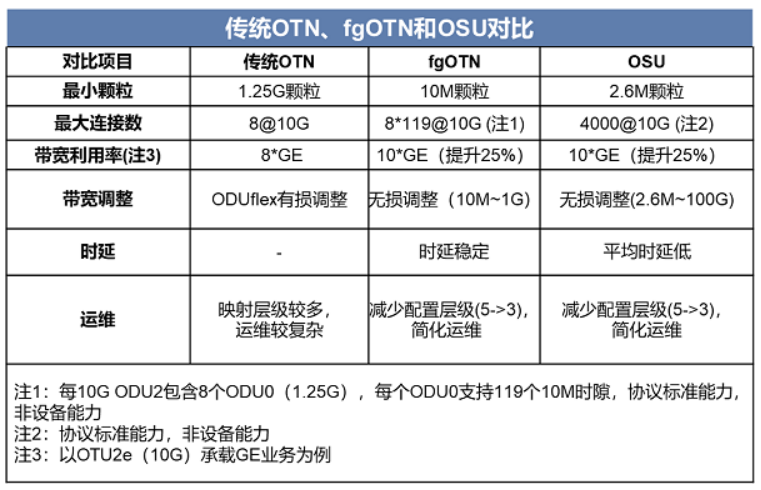-
Shenda Company Profile
- Company Profile
- Organization Chart
- Research & Development
- Honor & Certification
- Corporate Culture
- Address
- History

In summary, fgOTN and OSU, as the new generation of OTN technologies, aim to define fine-grained OTN connectivity SDH for Sub 1G, as well as improve OTN bandwidth utilization and flexible access capabilities. FGOTN adopts a fixed time slot allocation method, where each channel of FGODUflex is multiplexed into the OPUk with a fixed time slot position. The advantage is that the service delay is relatively stable, and CBR services such as E1/VC are better carried. The OSU adopts GTP time slot allocation method, and each OSU can flexibly reuse the time slots of OPUk. The advantage is that the service bearer is flexible, and the Ethernet service bearer is better.

Standardization status of fgOTN and OSU
In terms of standardization, the fgOTN standard was initially established as G. by ITU-T in February 2020 OSU, A research team based on OTN support for sub1G business requirements was identified. After multiple discussions, the standard scope was updated in September 2022, and the standard name was changed to G.fgOTN at the April 2023 plenary session. At present, ITU-T is completing the standardization of fgOTN, including the overall, interface, architecture, equipment, protection, clock, and control definitions of fgOTN. The three core standards of overall, interface, and architecture have been officially released in March 2024, while other standards are planned to enter the release process in the second half of 2024. Domestically, the fgOTN industry standard has been approved by the China Communications Standards Association (CCSA).
The main research objective of the OSU standard is the application of high-quality Ethernet dedicated lines by operators. In December 2019, the industry standards "Technical Requirements for Optical Service Units (OSUs)" and "Technical Requirements for Optical Transport Network (OTN) Equipment Based on Optical Service Units (OSUs)" were approved and published in CCSA, and were completed in April 2024. In terms of OSU control technology, in December 2021, CCSA established the industry standard "Technical Requirements for Optical Transport Network (OTN) Control Based on Optical Service Units (OSUs)", which is expected to be released in 2024. In addition, in the power industry, in June 2020, State Grid led the establishment of the OSUFlex standard for the Optical Transport Network (OTN) in the Institute of Electrical and Electronics Engineers (IEEE). The technical solution is consistent with the CCSA OSU industry standard and has now entered the standard release process.
FGOTN and OSU standard positioning and application
FGOTN is oriented towards the intergenerational evolution of SDH, based on TDM technology, continuing SDH's hard isolation, high reliability, and high security bearer for small particle services such as E1/VC, while also taking into account the dedicated line bearer for fine particle ETH services.

On the basis of traditional high bandwidth transmission in OTN, OSU provides small and massive business connection channels, enabling various businesses to be directly carried on the OTN network. It has the ability of high bandwidth efficiency, low latency, low jitter, and high-precision clock synchronization, and is suitable for applications in various systems.

Domestic and foreign operators and power grid companies actively participate in promoting the standardization process of fgOTN and OSU, collaborate with all parties in the industry chain, jointly promote product research and development, and accelerate industry maturity. It is reported that the domestic power industry is currently organizing verification tests for fgOTN technology, exploring the feasibility and typical application scenarios in power communication applications. It is expected to form application promotion suggestions through technical pilot projects. In addition, OSU has gradually been commercially deployed in some operator customer groups and the power industry, with a total of 2000+OSU business dedicated lines opened. It is expected to accelerate the pace of commercial scale in 2024.